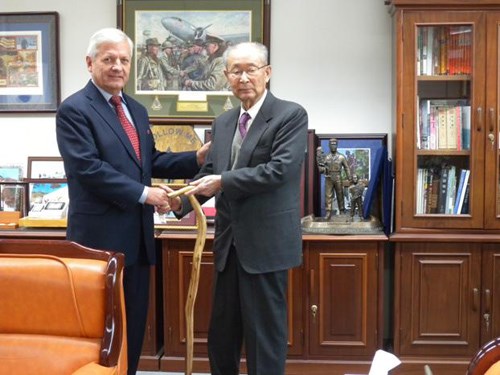Following the conclusion of World War II global relations would again be tested as the ideologies of Communism and Democracy would clash in the Cold War. A number of wars and crises developed pitting one group of people backed by the Soviets against another backed by the Americans.
In the Far East after World War II, the empire Japan had accumulated was disbanded. The Soviets attempting to spread their influence, as they hoped for a world revolution, thusly, occupied North Korea. In response the Americans occupied South Korea. At this time the American's provided small arms and light support weapons thinking this would prevent South Korea from invading North Korea to reunite the country; yet, when the American forces left it also meant the South Koreans wouldn't be able to defend themselves against the invading North Koreans.
In June of 1950 the North Koreans pushed into South Korea. Lightly armoured they were unable to repel this advance and lost much ground. At this time Brigadier General Paik Sun Yup, divisional commander of the Republic of Korea Army 1st Division was key in rallying South Korean troops to continue defending their land and beliefs.
Paik was able to combine scattered units to form a column of soldiers. At this time American fighter planes from Japan actually attacked this unit. To some soldiers all hope was lost at this moment, but General Paik offered words of encouragement. According to an article in the Korean War Veteran journal, Paik stated, "This is wonderful! They only attacked us because they thought we were North Koreans. This means the American air force is going to fight on our side."
Not only did the United States re-involve themselves in the conflict in Korea, but the young United Nations also joined. When armistice talks began in June of 1951 it was General Paik who represented South Korea on the United Nations Command delegation, though an armistice would not be signed until 1953.
Paik would be promoted to four star general and would become the Republic of Korea Army Chief of Staff. He would become the first Chief of Combined Staffs following the war and received the honourable title, "The Hero of Korea." He would also go on to become Korea's first ambassador to a number of countries including Canada.
Locally there is great importance in this history. James (Jim) Duncan originally of Arcola was one of the Canadians who fought in Korea with the United Nations. Duncan, son to Bill and Sarah Duncan and older brother to Margaret Carr of Arcola, had joined the army at 17-years-old and served as a lieutenant in the Royal Canadian Army Service Corps, retiring as Lieutenant Colonel.
In November of last year Duncan spoke at a ceremony where General Paik was an honoured guest in the Korean capital city of Seoul, which was hosted by Canada's Ambassador to Korea, David Chatterson. The ceremony was to present a painting to the War Memorial of Korea which was painted by Ted Zuber, a Canadian artist. Duncan presented the painting to the War Memorial of Korea and saluted General Paik during his speech.
Following the presentation Duncan was approached by Paik, who admired Duncan's hand carved walking cane. Paik offered a trade with his own cane; but, Duncan declined as he has become comfortable with it in offsetting a disability. Promising to find the carver Duncan said he would have one made which would be similar.
Duncan returned from Korea ill and was placed in isolation for over a week. Upon recovering he immediately began searching for the person who carved his unique cane. Once the carver was found, a limb of British Columbian hardwood was located that resembled Duncan's cane, and the carver went to work on it.
Once carved Duncan had a gold band etched with Paik's name attached to it. The cane was then sent to Colonel Jacques Morneau with the Canadian Defence Attache in Seoul who was able to set up a meeting with Paik. When presented with the cane Paik, who is now 93, began to use it immediately and was very appreciative of the gift.
A strong bond developed between South Korea and Canada during the Korean War and this small act of kindness on the part of Duncan has great meaning.
In Canada 2013 is actually, The Year of Korea, while in Korea it is, The Year of Canada. This marks the 60th anniversary of the end of the Korean War, and continues to show the deep connection developed in the early 1950s between the two countries.




